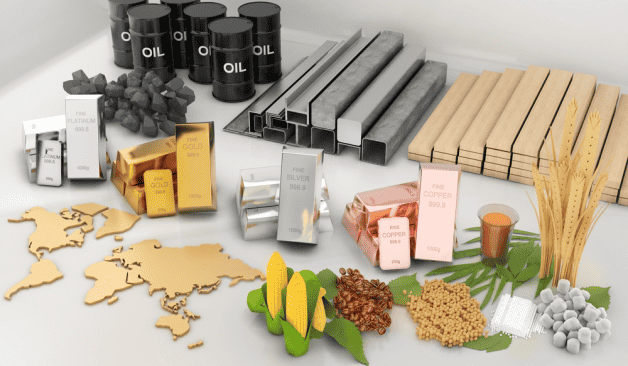
What are commodity mutual funds and how do you invest in them?
When it comes to different asset classes for investments, commodity investments are not on most lists, especially in India. We have said this often: investors should know every investment option available. In this article, we look at commodity mutual funds, and if you think they match your investment goals, we will also tell you how to invest in them.
What are commodity funds?
We will start with the basics: What is a commodity? A commodity is a basic good or raw material that's traded on exchanges. These commodities are not manufactured but extracted or harvested from nature. Commodities are essential for various industries and our daily lives. Examples include oil (energy), gold (jewelry, electronics), wheat (food), and cotton (clothing).
Now that you know commodities, understanding commodity funds is super simple. It is a type of mutual fund that invests primarily in commodities, which are raw materials or primary agricultural products that can be bought and sold, such as gold, silver, oil, natural gas, agricultural products (like wheat or corn), and other goods. Commodity mutual funds provide you with exposure to the price movements of these physical goods without having to directly purchase and store them.
Types of Commodity Funds
As you have figured out from the above definition, there are hundreds of different commodities available. To trade and invest in them, they have been classified as below:
- Basic Commodity Funds: These funds invest directly in physical commodities, such as gold, silver, oil, agricultural products, etc. They may hold the actual commodities themselves or invest in derivative contracts that track the price movements of these commodities.
- Natural Resources Funds: Natural resources funds invest in companies involved in the extraction, production, or distribution of natural resources, including commodities like oil, gas, metals, minerals, and timber. These funds typically invest in stocks of companies engaged in sectors such as energy, mining, forestry, and agriculture.
- Future Funds: Future funds, also known as commodity futures funds, invest primarily in futures contracts tied to the prices of commodities. Futures contracts are agreements to buy or sell a commodity at a predetermined price at a specified future date. It aims to profit from changes in commodity prices by buying futures contracts when they expect prices to rise and selling them when they expect prices to fall.
- Combination Funds: Combination funds invest in a mix of different types of commodities, natural resources stocks, futures contracts, and other related assets. The fund aims to provide diversified exposure to the commodities market while managing risk through a combination of asset classes.
- Index Funds: Commodity index funds track the performance of a specific commodity index. It replicates the index's returns by investing in a diversified portfolio of futures contracts or other financial instruments that mimic the index composition.
Who should invest in commodity funds?
Commodity funds can be a valuable addition to your portfolio, but they are not suitable for everyone. Here is a breakdown of who might benefit from investing in commodity funds:
Investors Seeking Diversification: Commodity prices often have a low correlation with stocks and bonds. Adding a commodity fund to your portfolio can help spread risk and potentially improve your portfolio's overall risk-adjusted return.
Investors Looking for a Hedge Against Inflation: Historically, commodity prices tend to rise with inflation. It can help protect the purchasing power of your investment over time.
Sophisticated Investors: Actively managed commodity futures funds can be complex and require a good understanding of futures contracts and the factors impacting commodity prices.
Benefits of investing in commodity funds
Here are some of the benefits of investing in commodity funds:
Reduced correlation with stocks and bonds: As mentioned earlier, commodity prices often have a low correlation with stocks and bonds. It means that when stocks and bonds are going down, commodity prices are likely to be going up, and vice versa. By adding a commodity fund to your portfolio, you can potentially reduce your overall portfolio risk and improve its risk-adjusted return.
Historically Rising Prices: Commodity prices tend to rise with inflation. It can help protect the purchasing power of your investment over time. As inflation erodes the value of your money, commodities can potentially maintain or even increase their value, offering a hedge against inflation.
Supply and Demand Dynamics: Commodity prices can fluctuate significantly based on supply and demand imbalances. If you invest in a commodity fund during a period of high demand and low supply, you could potentially see significant returns. However, keep in mind that the opposite can also happen, leading to losses.
Lower Investment Minimums: To directly invest in some commodities, you might require large sums. However, commodity funds often have lower minimum investment requirements, making them more accessible to a broader range of investors.
Risks to consider before investing in commodity funds
To this point, we have discussed everything positive about commodity funds, so before you finalize a commodity fund, you must also understand the risk. Here are some risks to consider:
Significant Price Swings: Commodity prices are notoriously volatile and can fluctuate dramatically due to various factors like weather patterns, geopolitical events, and supply and demand dynamics.
Lack of Transparency: The investment strategies of commodity funds (especially, actively managed) can be complex and not always transparent. Understanding how the fund manager makes investment decisions, and the associated risks can be challenging for some investors.
Currency Fluctuations: If a commodity fund invests in commodities traded in foreign currencies, fluctuations in exchange rates can impact the fund's returns.
 Top Mutual Funds
Top Mutual Funds



